#homebrew class
Text
So, you know how I said I was making 30 subclasses for Subclasseptember? I lied.
This one's a class, actually.

Subclasseptember Day 30: Choice
The Wildheart - Homebrew Class
The Wildheart is intended to fulfill a similar niche to Barbarian, but with its own flavor and a much more complex structure to provide the satisfying crunch that martials tend to otherwise lack.
Details under the cut.
This was a project that I'd been working on for a while over the last year. A complex martial, with similar build variety to the Warlock while not sacrificing the strengths of martial-oriented design. This was intended to contrast a simplistic mage whose build and combat choices would rival the elegance of a Champion Fighter. There's no reason that martials have to be the beginner's class and mages have to be the only choice for any actual variety in and out of combat.
The latter ended up being absorbed into the Swordmage, but the former ended up shelved - until now.
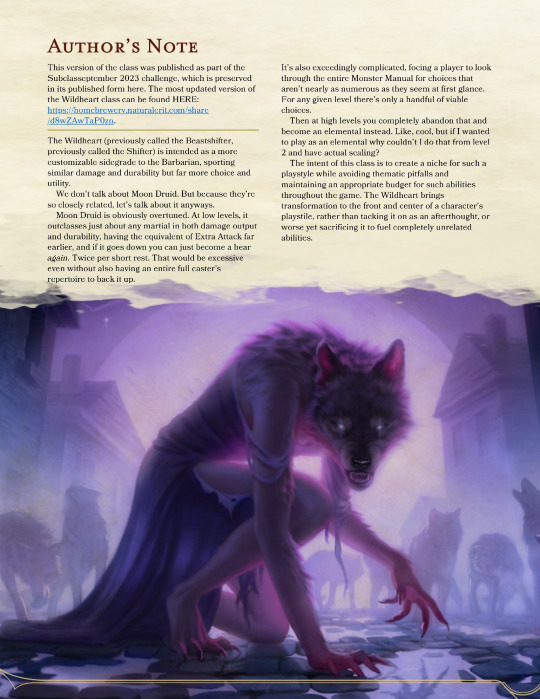
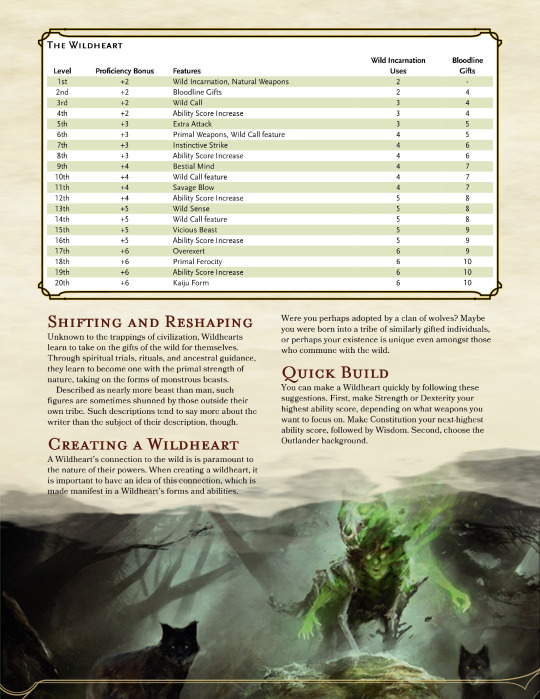
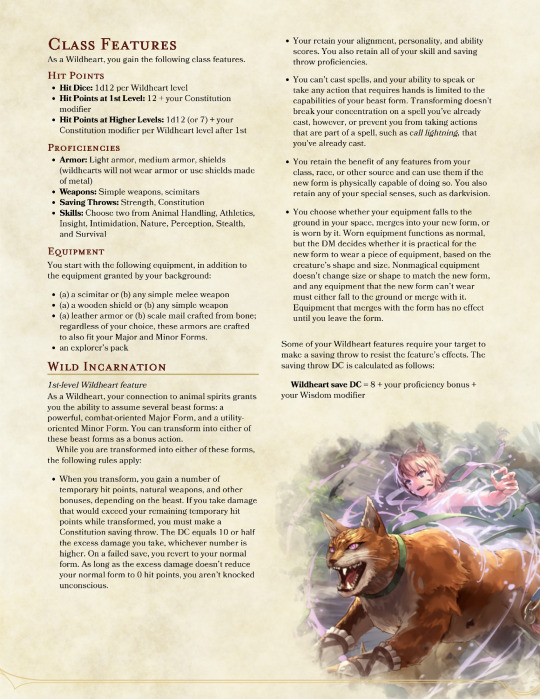

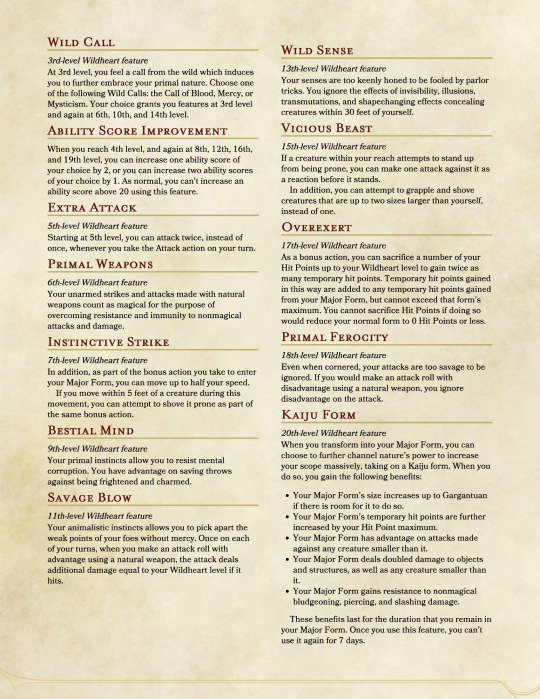
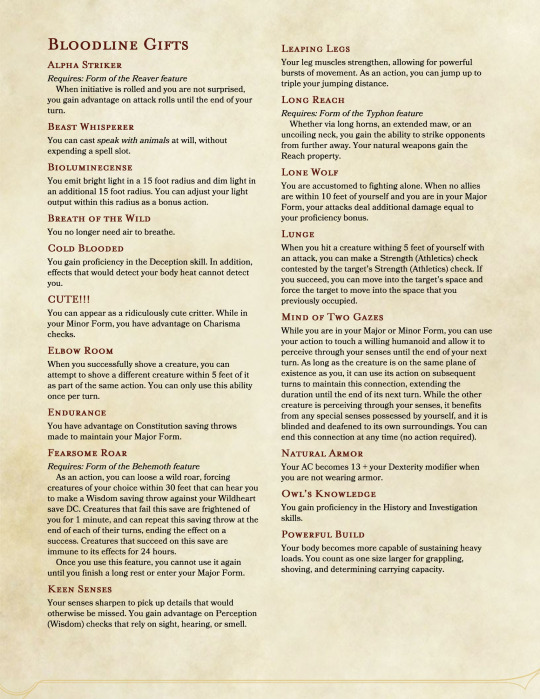



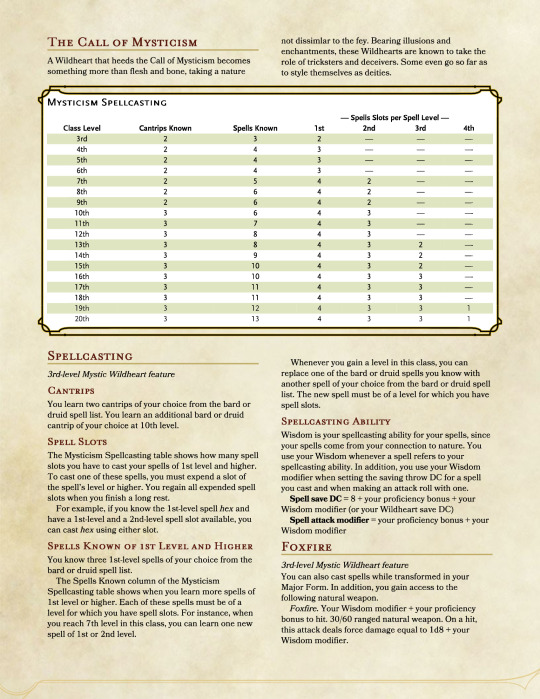
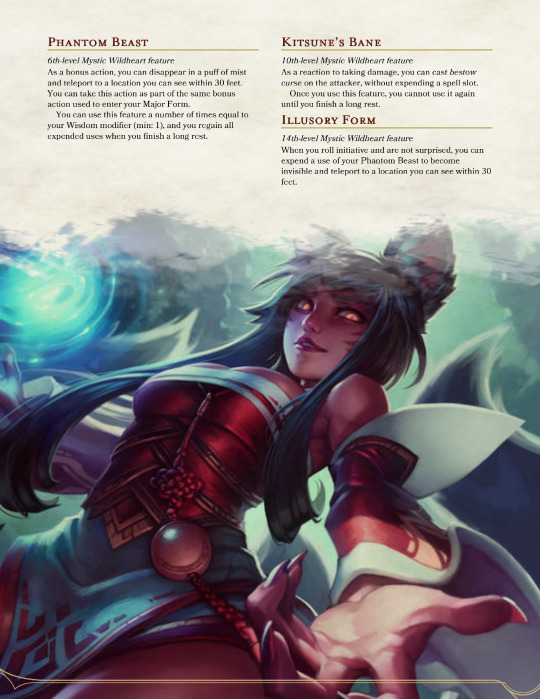
Subclasseptember has been a fun time, but I'm going to once again take a step back from brewing. Can't blame anyone else for not going all the way; it's definitely not an easy task. Wouldn't be called a challenge if it was.
Subclasseptember 2023 Compendium and DNDBeyond Links to come soon. Sadly, DNDBeyond still doesn't support homebrew classes.
Normally I'd make a funny quip here or something? But right now, all I can say is thank you everyone for your support. I intend to continue with these passion projects as long as I can. Albeit at a bit of a slower pace.
If you like what you see, I've got a ko-fi if you want to commission more of my stuff? It's in the pinned post on my page.
#my homebrew#d&d 5e#homebrew#dnd 5e homebrew#dnd homebrew#homebrew class#class#dnd#dungeons and dragons 5e#dnd dungeons and dragons#dnd 5th edition#5e homebrew#5e dnd#5e#homebrew 5e#dungeons and dragons#ttrpg#dnd 5e#druid#druid dnd#dnd druid#d&d druid#dnd5e#dndbeyond#fifth edition#homebrewery#homebrew subclass#5e d&d#d&d 5e homebrew#d&d
160 notes
·
View notes
Text
reposting homebrew!
hello all! now that things with wotc have Settled i've decided to repost my 5e homebrew as itch exclusives! enough people said they hoped they would go up again that it seemed like it was time to make them available once more. i'll be posting a few homebrew each sunday so keep a look out!
so without further ado ...
autism & adhd mechanics
11 total traits for pcs and npcs to mechanically emphasize their autism and/or adhd. includes disability specific and shared traits, including executive dysfunction, sensory processing disorder, motor issues, rejection sensitive dysphoria, and more! pay what you want! updated since the last time published!
wild magic artificer subclass
includes subclass spells, two brand new artificer infusions, a custom wild magic roll table, and access to magic tattoos!
witch class
a constitution-based half caster class with a brand new way of casting spells to add more strategy and risk to spellcasting. includes nearly 30 curses at levels 3, 10, and 15, including curses specific to your coven. adopt a familiar who grows in power as you do. includes the Enchanter - a coven focused on illusion and utility, the Hedgewitch - a coven focused on heals and buffs, and the Jinx - a coven focused on combat and necromancy. comes with a custom character sheet by bees baldwin. co-created with @beatricexbenedick
#dnd 5e#dnd 5e homebrew#homebrew subclass#homebrew class#HAPPY WITNESS AUTISTIC PEOPLE MONTH#PUTTING HOMEBREW BACK UP#a lot of these are going to be updated since the last drafts and some of the prices discounted#spreading the word much appreciated!! i know people were wanting these back up
369 notes
·
View notes
Text


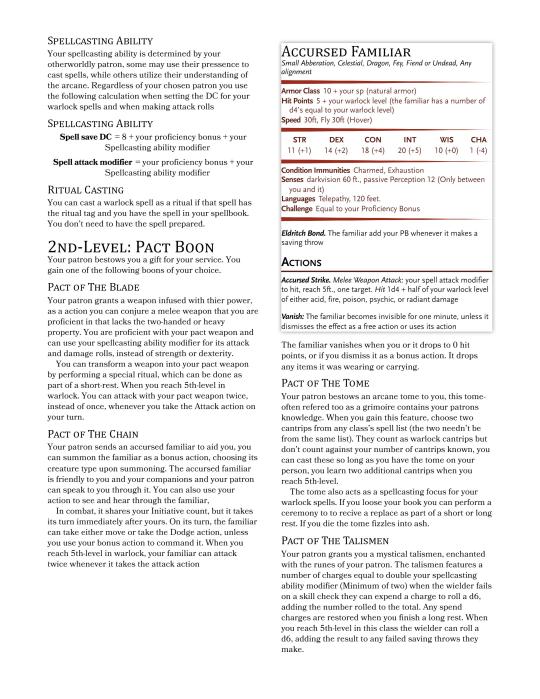



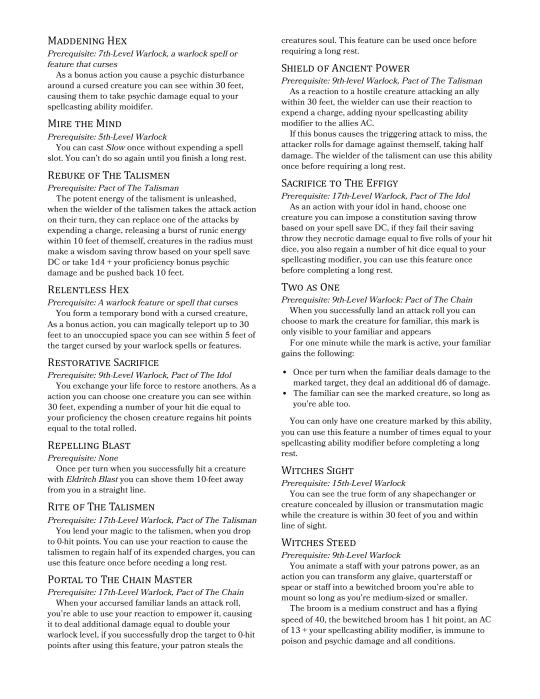


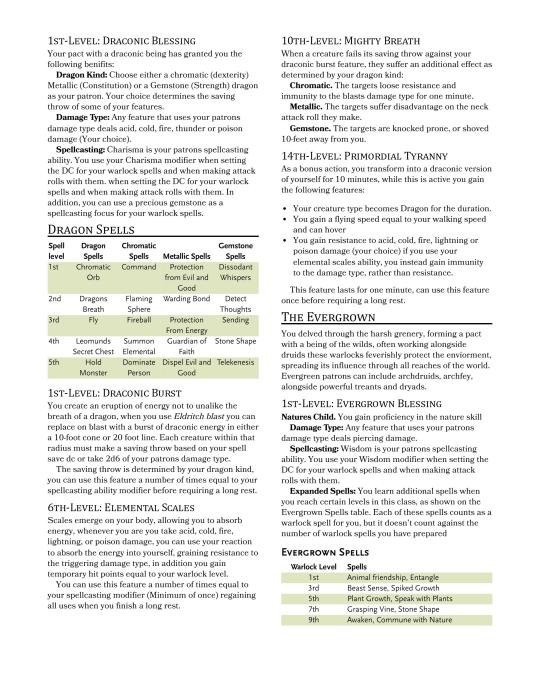


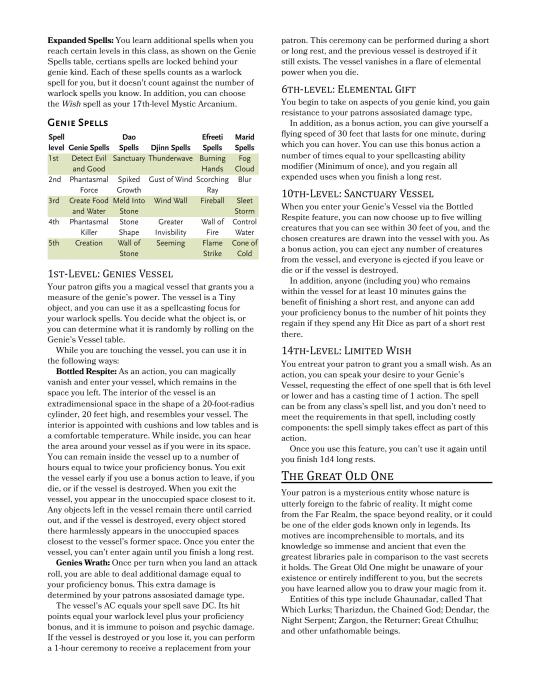





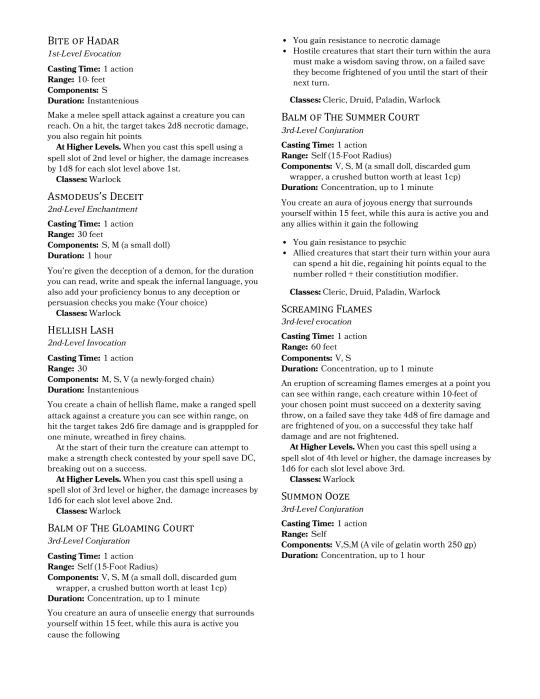

Hi there~!
It's been a long time coming, but here it is, my attempt at reworking the 5e warlock, due to my dissatisfaction with the version presented in One DND (5.5??) feature a whole host of reworked and altered options so you may be the best devil worshiper you can be, the rest of this post shall go over some of the changes made along with my intention behind the changes.
The base class.
For starters, eldritch blast is now a class feature. Simply put, every warlock takes eldritch blast, doesn't matter if you're focused on support, damage, or you're a weapon wielding hexblade, eldritch blast is such a good option, so I might as well give it as a base class feature. Similarly the agonizing blasts ability to add your charisma modifier to its damage rolls was added for similar reasons, skipping over the spellcasting, pact boon and invocation changes, the contact patron feature from the One DND UA was added for thematic purposes, and eldritch master was reworked to instead allow your patron to concentrate on a spell, which yes, does allow you to concentrate on two spells at one (At disadvantage)
Spellcasting.
The One DND warlock features the rather unique ability to choose between intelligence, wisdom or charisma as its casting stat, while I enjoyed the concept I decided to take it a step further by tying your spellcasting ability to the otherworldly patrons themselves, essentially using their spellcasting stat in a way.
Additional changes include you getting your 3rd-level slot at 6th-level as opposed to 11th, cause the highest most dnd campaigns reach are around 10-11th level, and it feels bad having to wait all the way until then just to cast three spells a day, some other changes of note include the warlock being able to ritually cast, and the spells gained from their otherworldly patron are now automatically prepared, rather than added to the warlock spell list. Which i'm not sure why they did that? Unless they though the warlock would be too good?
The Pact boons.
Basically every pact boon got upped in power, such as pact of the blade and pact of the chain, alongside them growing in strength when you reach 5th-level, in addition, two new pact boons were added. The first being the Pact of The Gunpowder, based on the Pact of The Trigger by MonkeyDM, its an eldritch blast/cantrip focused pact for those who want to truly commit themselves to the eldritch blast lifestyle, alongside the Pact of The Idol, allowing you to sacrifice your hit dice to perform various features.
Eldritch Invocations.
A selection of (Mostly new) invocations were made for this document, my favorite would have to be the ones given to the pact of the blade. Admittedly in the rush to get this out by the deadline I chose to cut back on the invocations in particular, but who knows, maybe when I get to revising this someday I can add even more invocations to the list.
Subclasses
All of the subclasses were revised in one way or another, but for the sake of time i'll go other three in particular: The Hexblade, The Horror and The Undying. The hexblade is a rather infamous subclass within the DND community in no small part cause of how strong a 1st-level dip is for many characters (Cough, paladin) but the more I looked at it, the more I found myself bored of it. Don't get me wrong the 5e hexblade is rather powerful, but it just doesn't scratch the itch of the cursed item patron, and with hex warriors main drawing being ported over to pact of the blade, reworking was a must. The horror (Originally called the undead) I generally don't have to many issues mechanics wise, in fact it's one of my favorite warlock subclass, my only gripe is cause of how much if steps on the undying toes flavor-wise, speaking of which, the undying is possibly the subclass I had the most fun reworking, transforming it into a tanky summon focused as opposed to....Whatever the original was trying to accomplish.
Along with the revision of old subclasses, three new subclasses are included: The Arcanist, The Dragon and The Evergreen. The arcanist is a pact with a powerful being of magic (Such as an archmage) it allows you to learn wizard spells from your pact magic feature, manipulate your spellcasting and eventually imbue spells into trinkets, the dragon are for those that simply want blast their foes away, you can create bursts of draconic energy, absorb elemental energy and even assume the form of a dragon, lastly the evergreen is for those that couldn't decide if they wanted to be a druid or a warlock, allowing you to create a garden around yourself that damages enemies, alongside implanting magic seeds within your foes and protecting allies within your garden against spells, similar to an ancients paladin.
New spells
Because I like making more work for myself, a handful of new spells are available at the end of the document, so I apologize if they're a bit on the lower end quality wise, but I hope they'll be at least somewhat interesting.
That's about all I wanted to talk about in relation to this rework, keep in mind everything in here is untested, and I encourage anyone reading this to leave any thoughts or constructive criticism they may have. With that in mind, thank you for reading, go out and make something cool.
#dnd homebrew#dnd5e#5e homebrew#dnd#homebrew 5e#5e#dnd warlock#dungeons and dragons#dungeons and dragons homebrew#dnd 5e homebrew#homebrew class#homebrew#5e warlock#warlock
84 notes
·
View notes
Text
The Priest Class Update!
The 'Truth and Lies' Update
Level 1-17 Playtest - V1.0
For people who haven't seen before, priest is a point-based, divine spellcaster, with a big focus on customisability
You can choose:
What your casting stat is (Int/Wis/Cha)
Your Method of Worship, a subclass that augments spellcasting (Prayer, Sacrifice, Song, Spirit, Study)
Your Divine Calling, a second subclass that impacts your general playstyle (Cultist, Judge, Oracle, Truthseeker)
Your Deity's Domain, a small expanded spell list with a bonus feature, as you level you gain more and can channel a different one each day (16 options currently)
The document also contains a bunch of spells, and a feat to let you tap into the power of the priest!
New to this update are level 14 features for all Methods of Worship, the Trickery Deity's Domain (as voted on by members of my Discord Server), the Truthseeker Divine calling, and the 8th and 9th level spells for the class!
If you want to keep up to date on teasers, help shape the design going forward, and/or vote on future inclusions, come join the Discord!
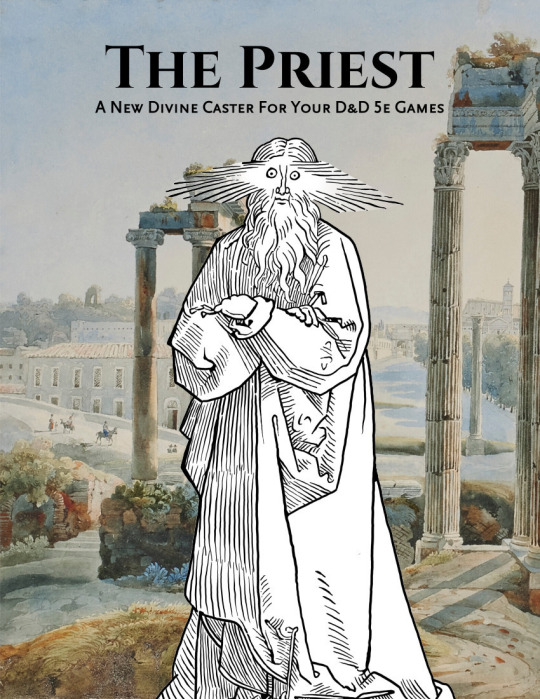
#d&d#dungeons and dragons#dnd homebrew#homebrew#5e homebrew#dnd5e#dnd 5e#dnd#ttrpg#fantasy#jay's brewery#priest class#d&d homebrew#homebrew class#dnd class#dnd classes#cleric#dnd design
21 notes
·
View notes
Text
So as something of a preview for the Swordmage (the first draft of which is nearly complete), I’m previewing a few of the unique spells it gains access to: Spellstrike Spells.
These are designed in a similar vein to the various Smite spells. Each of them is based on the same amount of damage as a smite, but has a casting time of 1 action. Reason being that they're designed to he use alongside Spellstrike as a feature (which integrates a weapon attack into the casting of the spell).

Thundering Spellstrike is pretty simple, designed to push an opponent back. I wondered about adding more distance or a prone effect, might add that in the final version.

Shocking Spellstrike is another simple but very strong one, doing lightning damage and a stun.
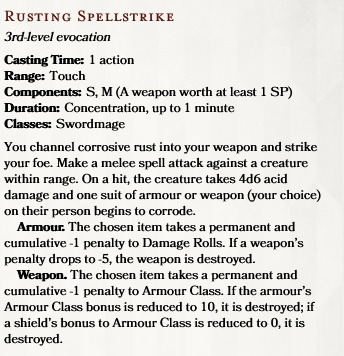
A personal favourite, what if we made the Rust Monster's abilities into a spell? Being able to degrade armour and weapons is a real neat feature and I'm surprised its not seen more in official stuff.

So far the only Ranged Spellstrike spell, very much designed after the Warp-Strike in FF15. Hit someone, teleport to them, pretty straightforward
26 notes
·
View notes
Text
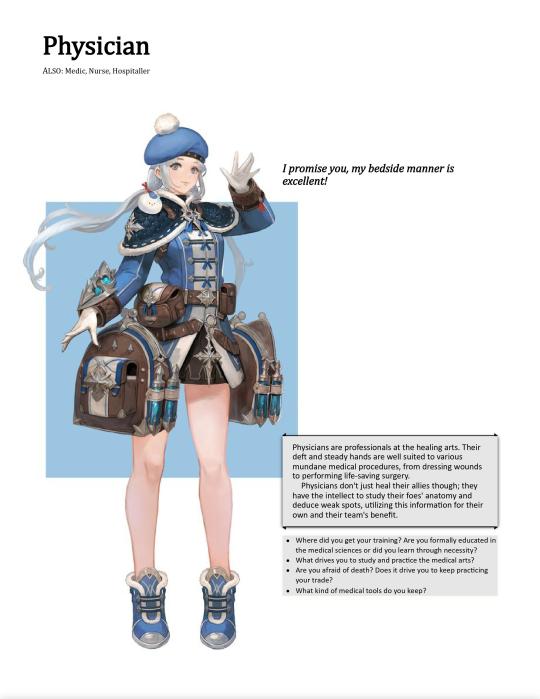

Heyo and a hello! I return with a homebrew class for an entirely different system instead of my usual D&D 5e! This is my take on a Doctor/Nurse/Combat Medic/Mundane Healer for Fabula Ultima called the Physician!
It's really interesting homebrewing for other systems, doubly so for Fabula Ultima I feel because of the system's heavy reliance, bordering on dependence, on multiclassing. This makes it so that any class you homebrew would have to synergize/combo off of skills from at least 3-4 other classes? Idk tbh, I'm still figuring things out for myself lmao
Anyways, feel free to use this in your home games and leave constructive criticism! As I said, still figuring out what makes good Fabula homebrew, so any pointers in that direction would be much appreciated!
GM Binder link: https://www.gmbinder.com/share/-NOWJZgWe3k5qRFZMJnR
#fabula ultima#homebrew#homebrew class#the physician#I really just defaulted to combat medic upon switching systems#its familiar to me#like a childhood blanket
73 notes
·
View notes
Text

My first kickstarter, and second book, is ready to go! The Fey's Guide to Epic Levels provides the outlines and classes for play above the 20th level! There's an epic class with lore for every core class within 5th edition. Link in reblog!
44 notes
·
View notes
Text
Nebula Faction - Dragon Knight

On day 21 of JanBrewary we looked to the sun for inspiration. So I dusted off an idea I'd had in my back catalogue for a while. A Dragon Knight faction inspired by the dragons found in the astral sea.
[Subclass Link] [Class Link] [Link to Prompts]
I wonder if anyone can guess which subclass this draws a lot of mechanical inspiration from?
#janbrewary#akkator's compendium#dnd#dnd homebrew#dnd 5e#d&d#d&d 5e#d&d homebrew#Dragon Knight#homebrewery#homebrew class
7 notes
·
View notes
Text
#dnd#dnd classes#bard#dnd bard#gunglinger#dnd gunslinger#homebrew class#bard class#dungeons and dragons#d&d 5e#5e#d&d#winsome’s wailings
53 notes
·
View notes
Text




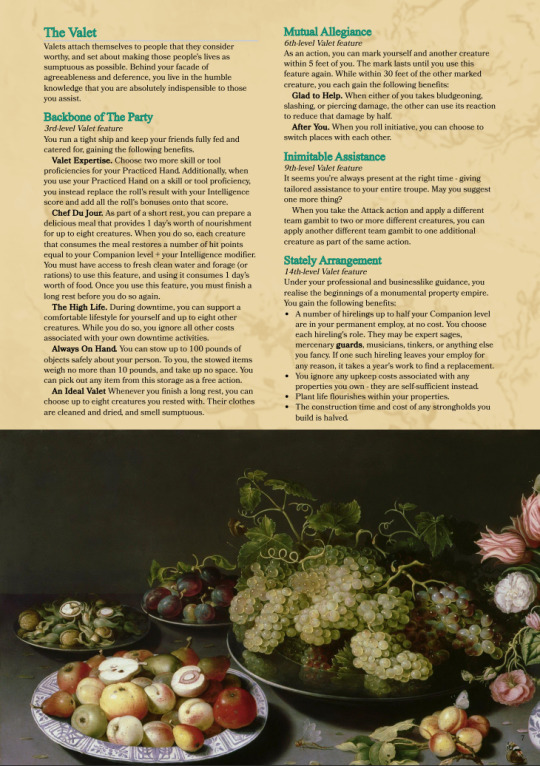
For too long has this class occupied free permanent real estate inside my feeble brain. I wanted to make a new form of nonmagical class, based on the classic character trope of the sidekick, shamefully underrepresented in RPGs. The samwise to their frodo, the puppycat to their bee, the jeeves to their wooster. I've been meddling with this thing since like 2018 or something, and finally it's in a state that I really like!
The core of the class is that you trade your own attacks in to give your allies bursts of alacrity - dashing, disengaging, dodging, grappling, focusing, healing, or even making extra attacks themselves! Then, as long as you haven't attacked, you get to whack a foe once with your bonus action.
The other core of the class is that you're a reliable pal, and great to have around. You've got a knack for reliability, a free second background, and the ability to botch together any piece of adventuring gear from whatever doodads you've got lying around!
Links on the way, and a full text copy of the class below the break.
Warning: 4500 words long!
The Companion
Hastily scrawling down notes, an apprentice mage hurries after her wizard compatriot, frantically trying to beckon her nonplussed friend away from the horrifying monstrosity bearing down on him. Wiping his hands off, a grinning dwarven cook joins in with the fireside discussion as his companions tuck into the delicious breakfast he has prepared. Patting her injured protégé on the shoulder, an ancient dragonborn sensei lifts her young charge to his feet, granting him the reassurance he needs to fight on.
All of these characters are companions, happy to take a back seat from all the heroism and simply keep their compatriots in the best stead they possibly can. Their power lies in hard work, strong bonds, and tactical nouse.
A Helping Hand
The companion represents any kind soul that seeks to devote themselves wholeheartedly to elevating others - and sets their brilliant mind upon perfecting their dutiful care. Doting and maternal, their capabilities stem from a studied understanding of others.
Though they choose to forego the brashness and burliness traditionally associated with heroism, their talent for kindness and tactical nouse makes them an indispensable addition to any team. They can rejuvenate, encourage, and rescue their allies with a few well-placed words and a dusting of spices.
Pulling the Strings
Companions are best able to exploit their prodigious capabilities from the back lines of combat, away from danger, where they can help others administer rapid aid to the fallen, or assist archers in pursuit of their marks. When they fight, they do so best with the simple farm tools of their trade: even though they lack the armaments bestowed upon their martial counterparts, the companion's rustic dedication to self-taught workmanship makes them incomparably consistent with their strikes - more reliable than even the burliest of warriors.
Companion adventurers are dedicated and loyal tacticians, studying their friends closely enough to know when and how to aid and direct them. As they watch their party fumble, bluff and bluster, the companion prefers to smile knowingly, look on affectionately, and stay out of the limelight; aware that if their allies break out into combat, the odds will be squarely in their favor.
The companion might seem a subdued, maternal figure to their fellows, but they are the brains of the operation.
Creating a Companion
As you create your companion character, think about why they chose to help out this specific group of adventurers, and who among the party they consider themselves closest to. The companion is a class of close personal bonds, and bonds should be your foci. Are they the mentor or the mentee? Do they resent their role in the group, and if so, why? What impact does their experience (or, perhaps, lack of it) have on their behavior?
Quick Build
You can make a companion quickly by following these suggestions. First, make Strength or Dexterity your highest ability score, depending on whether you want to focus on melee weapons or on ranged combat (or finesse weapons). Your next highest score should be Intelligence. Second, choose the guild artisan background.
Versatile Score
At your DM's option, you can choose Charisma or Wisdom and use that ability score in place of Intelligence for your Companion features. If you choose Wisdom, your save proficiencies don't change.
##########
Class Features
##########
As a companion, you gain the following class features.
Hit Points
Hit Dice: 1d8 per companion level
Hit Points at 1st Level: 8 + your Constitution modifier
Hit Points at Higher Levels: 1d8 (or 5) + your Constitution modifier per companion level above the 1st Proficiencies
Armor: Light armor, medium armor, shields
Weapons: Simple weapons, war picks, whips
Saving Throws: Intelligence, Wisdom
Skills: Choose two from Animal Handling, Athletics, History, Investigation, Nature and Medicine
Equipment
You start off with the following equipment in addition to the equipment granted by your background:
(a) any two simple melee weapons, (b) a shield, or (c) a war pick (perhaps a hammer, cane, or mattock).
(a) 5 darts, a sling, and 20 bullets, or (b) a whip
(a) leather armor or (b) hide armor
A healer's kit and an explorer's pack.
If you forego this starting equipment, as well as the items offered by your background, you start with 3d4 × 10 gp to buy your equipment.
Multiclassing
If your group uses the optional rule on multiclassing in the Player’s Handbook (p. 163), here’s what you need to know if you choose companion as one of your classes.
Ability Score Minimum. As a multiclass character, you must have at least a Dexterity score of 13 and a Intelligence score of 13 to take a level in this class.
Proficiencies Gained. If companion isn’t your initial class, here are the proficiencies you gain when you take your first level as an companion: light armor, medium armor, shields, simple weapons.
Storied Past
When you choose this class at 1st level, you hark back to the experiences that brought you here.
Choose a second background from the Player's Handbook, in addition to your own. You gain the skill proficiencies, tool proficiencies and languages associated with that background, as well as its associated feature.
Teamwork
Beginning at 1st level, you can use your action to lend a helpful order to your allies - a team gambit. If you’re able to make multiple attacks with the Attack action, you can replace one or more of them with a team gambit.
Choose another creature within 60 feet of you that isn't incapacitated and that you can communicate with. You lend it a burst of alacrity, choosing one team gambit that you know and granting its benefits to the target. A creature can't be affected by the same gambit more than once per turn.
You know two team gambits at 1st level, which you choose from the Team Gambit List. You learn additional gambits as you gain levels in this class, as shown in the Team Gambits Known column of the Companion table. Each time you gain a level in this class, you can replace one gambit you know with a different gambit of your choice from the Team Gambit List.
If a gambit has prerequisites, you must meet them to learn it. You can learn the gambit at the same time that you meet its prerequisites. A level prerequisite refers to your level in this class. Gambits can be used outside combat.
Team Gambit List
Attack Gambit
If the target takes the Attack action on its next turn, it can make one additional attack as part of the same action.
Dodge Gambit
(Prerequesite: 9th level)
You call out incoming attacks against the target. Until the start of your next turn, any attack roll made against the target has disadvantage if you can see the attacker, and the target makes Dexterity saving throws with advantage.
Focus Gambit
(Prerequesite: 5th level)
You provide instruction that helps the target focus its mind. Choose Intelligence, Wisdom or Charisma, and roll 1d4. Until the start of your next turn, the target adds the result to attack rolls, ability checks, and saving throws.
Help Gambit
Once before the end of your next turn, if the target fails an ability check or misses with an attack roll, it can reroll one of the dice once.
Offense Gambit
You bolster the target with a warcry. The next time the target rolls damage before the start of your next turn, it adds your Intelligence modifier to the result.
Reflex Gambit
(Prerequesite: 5th level)
The target focuses on disrupting its foes, and regains the use of its reaction. Until the start of your next turn, hostile creatures within the target's reach provoke opportunity attacks from it whenever they attack a creature other than the target.
Rejuvenating Gambit
You offer a few calming words to the target. It can use its reaction to spend a hit die to heal itself. It rolls the die, adds its Constitution modifier, and regains a number of hit points equal to the total (minimum of 1). Until the start of your next turn, whenever the target makes a Constitution saving throw, it treats a roll of 9 or lower as a 10.
Scout Gambit
The target can immediately use its reaction to move up to its movement without provoking opportunity attacks. If it doesn't move through a hostile creature's reach during this movement, it can take the Hide or Search action as part of the same reaction, gaining a bonus to its check equal to your Intelligence modifier.
Shove Gambit
The target can immediately use its reaction to attempt to grapple or shove a creature within its reach. If it does so, it gains a bonus to its check equal to your Intelligence modifier.
Utility Gambit
(Prerequesite: 5th level)
The target can immediately use its reaction to use an object, draw a weapon, or drink a potion. You can hand the object to them as part of this gambit.
Alternately, you can use this gambit to administer a potion or healer's kit to a creature within 5 feet of you.
Companion's Attack
You follow up your helpful gambits with a swift blow. Beginning at 2nd level, you can make a weapon attack as a bonus action.
You can't use this bonus action on a turn where you use an action to cast a spell, attack a creature, or force another creature to make a saving throw - nor can you use it when you ready such an action.
Practiced Hand
At 2nd level, choose one of your skill or tool proficiencies. When you roll an ability check with the chosen proficiency, you can replace the total with your Intelligence score.
Additionally, choose two types of weapons you are proficient with. When you miss with an attack with that type of weapon, you can replace the attack roll's total with your Intelligence score, potentially turning it into a hit.
Once you use this feature, you can't use it on the same proficiency again until you finish a long rest. You can change your choice of proficiencies or weapons whenever you gain a level in this class.
At 7th level, you choose one more of your proficiencies and two additional weapons you are proficient with to gain the benefits of this feature.
Line of Work
At 3rd level, you choose a line of work that grants you skill in a certain field, as well as a few helpful fighting techniques. Choose a line of work from the Apprentice, Squire, or Valet, all detailed at the end of the class description. The line of work you choose grants you features at 3rd level, and again at 6th, 9th, and 14th level.
Ability Score Improvement
When you reach 4th, 8th, 10th, 12th, 16th, and 19th level, you can increase one ability score of your choice by 2, or you can increase two ability scores of your choice by 1. As normal, you can’t increase an ability score above 20 using this feature.
Bodge Job
Once you reach 4th level in this class, you're never short of materials, and whenever someone seems to be in need of something you can botch it together from bits and bobs pulled out of nowhere.
As an action, you can piece together a functional imitation of a weapon or solid piece of adventuring gear. The object you craft is flimsy, and breaks 1 hour after you create it.
You have a number of uses of this feature equal to your Intelligence modifier, and you regain any expended uses when you finish a long rest.
From 18th level, objects you create last for 24 hours.
Extra Attack
Beginning at 5th level, you can attack twice, instead of once, whenever you take the Attack action on your turn.
Helping Hand
Beginning at 8th level, whenever you help a creature with an ability check, the target can use your bonus to the check in place of its own.
Companion's Command
Beginning at 11th level, you gain great flashes of tactical brilliance that can help your partners to excel in combat.
As an action, you choose another creature within 60 feet of you that you can communicate with. You give the target a rousing command - one it could achieve using its movement and action. For example, you could say "Kellen! Run here and cast wall of fire covering this area between these gnolls" or you could say "Naia! Attack!".
The target can immediately use its reaction to take an extra turn, carrying out any movement or action you described. If something prevents the target from carrying out the command, you choose what it does instead.
On this extra turn, the target can't take bonus actions, and it doesn't regain its reaction.
You have a number of uses of this feature equal to your Intelligence modifier (minimum of one), and you regain all expended uses when you finish a long rest.
Contingency Plans
At 13th level, you're completely prepared for any eventuality, no matter how bizarre or unlucky. If you have disadvantage on an attack roll, ability check, or saving throw, you roll once instead of twice and take the result.
Saving Grace
Once you reach 15th level, you're seldom caught off guard. You can use a bonus action to galvanize a creature with resilience. Choose Dexterity, Constitution, or Wisdom. Until you use this feature again, the target adds 1d4 to its saving throws using the chosen ability score
The Bonds of Friendship
Once you reach 15th level you can offer yourself to the whims of fate to save those closest to you.
When an effect reduces a creature within 60 feet of you to 0 hit points or kills them outright, you can call upon a dazzling burst of devotion that ends all conditions affecting both you and the target and instantly brings you into a location within 5 feet of the target.
The effect is redirected to you, and doesn't affect the target. If you survive it, you fall unconscious at 0 hit points and can't be healed or stabilised by another creature.
Once you use this feature, you can't use it again for 10 days.
Unfailing Companionship
Once you reach 17th level, when you roll initiative and have no uses of Companion's Command left, you regain one use.
Additionally, when you instruct a creature with your Companion's Command, its first weapon attack on its extra turn deals an additional 2d12 damage.
Art of the Bodge
You become an almost supernally competent odd-jobber. You can spend 10 minutes botching together a functional imitation of armor, barding, any drawn vehicle, a rowboat, a keelboat, or any other nonmagical object no larger than a 10-foot cube. The object lasts for 24 hours.
Once you use this feature, you must finish a long rest before you do so again.
Masterclass
At 20th level, you gain a +2 bonus to your proficiency bonus.
Lines of Work
Your line of work is a reflection of your particular skillset - the manner in which you go about supporting your allies.
The Apprentice
You're an ideal assistant to the bookish scholars or magic users. With a plethora of information-gathering tools, battle control spells, and handy familiars and rituals, you become a beloved magical assistant.
Frantic Scribbling- 3rd-level Apprentice feature
You begin noting down the escapades of your group, filling reams upon reams of parchment with scribblings and notes. You have an accurate physical recording of anything you have seen or heard within the past month, including in combat
Spellcasting-3rd-level Apprentice feature
When you choose this line of work, you learn to cast spells through devotion, education, and study. Most apprentices study wizardry, but your DM may allow you to use the Cleric Spell List for this subclass instead, choosing divination and transmutation spells.
Cantrips. You learn three cantrips from the wizard spell list. You learn an additional cantrip once you reach 10th level in this class.
Spell Slots. The Apprentice Spellcasting table shows how many spell slots you have to cast your spells of 1st level and higher. To cast one of these spells, you must expend a slot of the spell's level or higher. You regain all expended spell slots when you finish a long rest.
For example. if you know the 1st level spell find familiar and have a 1st level and a 2nd level spell slot available, you can cast find familiar using either slot.
Spells Known of 1st-Level and Higher. You know three 1st level wizard spells of your choice, two of which you must choose from the conjuration and divination spells on the Wizard Spell List.
The Spells Known column of the Apprentice Spellcasting table shows when you learn more wizard spells of 1st level or higher. Each of these spells must be conjuration or divination spells of your choice, and must be of a level for which you have spell slots. For instance, when you reach 7th level in this class, you can learn one new spell of 1st or 2nd level.
The spells you learn at 8th, 14th, and 20th level can come from any school of magic.
Whenever you gain a level in this class, you can replace one of the spells you know with another spell of your choice from the Wizard spell list. The new spell must be of a level for which you have spell slots. and it must be a divination or evocation spell, unless you're replacing the spell you gained at 8th, 14th, or 20th level.
Spellcasting Ability. Intelligence is your spellcasting ability for any spells you learn using this feature, since you employ memorization to learn your spells.
You use your Intelligence whenever a spell refers to your spellcasting ability. In addition, you use your Intelligence modifier when setting the saving throw DC for a spell you cast with this feature, and when making a spell attack roll.
Spell Save DC = 8 + your proficiency bonus +
your Intelligence modifier
Spell attack modifier = your proficiency bonus +
your Intelligence modifier
Ritual Casting. You can cast any wizard spell you know as a ritual if that spell has the ritual tag.
Apprentice Spellcasting
Apprentice Level/Cantrips known/Spells Known/1st/2nd/3rd/4th
2nd 3 3 2 –– –– ––
3rd 3 3 2 –– –– ––
4th 3 4 3 –– –– ––
5th 3 4 3 –– –– ––
6th 3 4 3 –– –– ––
7th 3 5 4 2 –– ––
8th 3 6 4 2 –– ––
9th 3 6 4 2 –– ––
10th 4 7 4 3 –– ––
11th 4 8 4 3 –– ––
12th 4 8 4 3 –– ––
13th 4 9 4 3 2 ––
14th 4 10 4 3 2 ––
15th 4 10 4 3 2 ––
16th 4 11 4 3 3 ––
17th 4 11 4 3 3 ––
18th 4 11 4 3 3 ––
19th 4 12 4 3 3 1
20th 4 13 4 3 3 1
Battle Magic-6th-level Apprentice feature
While you aren't wearing heavy armor or wielding a shield, you can use your Companion's Attack on any turn when you use your action to cast a spell.
Spell Swapping-6th-level Apprentice feature
Once per day, at the end of a short or long rest, you can spend 1 minute helping an ally swap the spells they can cast. The creature you help may choose a new list of prepared spells as if it had just finished a long rest. Alternately, if it knows spells, it can choose one of the spells it knows of 1st level or higher and replace it with another spell from that class's spell list. The new spell must be of a level that they can learn.
Apprenticeship-9th-level Apprentice feature
You can study spellcasters rapidly enough that you can roughly imitate their spells. Whenever you see a friendly creature within 60 feet of you cast a spell of a level for which you have spell slots, you can use your reaction to learn a copy of that spell. For the next minute, you can cast the spell using your spell slots.
Once you cast a spell with this feature, you can't use this feature again until you finish a long rest.
Magical Gambit-14th-level Apprentice feature
As a masterful magician, you gain the following unique team gambit. It doesn't count against your number of gambits known. You may only use it once per turn.
Cast A Spell.
The target can immediately use its reaction to cast a 1st-level spell with a casting time of 1 action or 1 bonus action using its spell slots.
The Squire Line Of Work
You are a gallant companion to one of the martial folk in your group, working to aid them and eager to acquire or share any fighting know-how you can. You might be training beneath them, or, on the contrary, they could be your protégé themselves.
Bonus Proficiencies-3rd-level Squire feature
When you choose this line of work, you gain proficiency with heavy armor and martial weapons.
Call to Arms-3rd-level Squire feature
You can rally your allies with an encouraging cry. As a bonus action on your turn, you may choose a friendly creature within 60 feet of you that you can communicate with. Until the start of your next turn, the target gains a bonus to AC equal to your Intelligence modifier, and it has advantage on attack rolls.
You have a number of uses of this feature equal to your Proficiency bonus, and you regain any expended uses when you finish a long rest.
Fighting Style-6th-level Squire feature
You adopt a particular style of fighting as your specialty. Choose one of the following options. You can't take a Fighting Style option more than once, even if you later get to choose again.
Dueling. When you are wielding a melee weapon in one hand and no other weapons, you gain a +2 bonus to damage rolls with that weapon.
Defense. While you are wearing armor, you gain a +1 bonus to AC.
Interception.
When a creature you can see hits a target, other than you, within 5 feet of you with an attack, you can use your reaction to reduce the damage the target takes by 1d10 + your proficiency bonus (to a minimum of 0 damage). You must be wielding a shield or a simple or martial weapon to use this reaction.
Protection.
When a creature you can see attacks a target other than you that is within 5 feet of you, you can use your reaction to impose disadvantage on the attack roll. You must be wielding a shield.
Warhorse Trainer-9th-level Squire feature
By spending 8 hours tending to a beast with an Intelligence score of 3 or lower, and pampering and feeding it, you can train it to accept a rider and act as a controlled mount in combat. Your DM determines if a beast will accept this training, and whether they have appropriate anatomy to serve as a mount once trained.
Additionally, when you take the Attack action, you can choose a beast trained as a mount within 60 feet of you, and give it a team gambit as part of the same action.
Banner Bearer-14th-level Squire feature
You craft a banner that has a crest you associate with yourself or your close friends. The banner has an AC of 18 and a number of hit points equal to thrice your Companion level. If the banner is destroyed or damaged, you can spend 10 minutes repairing it as part of a short or long rest to restore all its missing hit points.
Any creature can wield the banner in a free hand, mount it on their back, or plant it in the ground. The banner inspires creatures that are friendly to you within a 15-foot sphere centered on it. Such creatures can't be frightened, grappled, or knocked prone.
The Valet Line of Work
Valets attach themselves to people that they consider worthy, and set about making those people's lives as sumptuous as possible. Behind your facade of agreeableness and deference, you live in the humble knowledge that you are absolutely indispensible to those you assist.
Backbone of The Party-3rd-level Valet feature
You run a tight ship and keep your friends fully fed and catered for, gaining the following benefits.
1: Valet Expertise. Choose two more skill or tool proficiencies for your Practiced Hand.Additionally, when you use your Practiced Hand on a skill or tool proficiency, you instead replace the roll's result with your Intelligence score and add all the roll's bonuses onto that score.
2: Chef Du Jour. As part of a short rest, you can prepare a delicious meal that provides 1 day’s worth of nourishment for up to eight creatures. When you do so, each creature that consumes the meal restores a number of hit points equal to your Companion level + your Intelligence modifier. You must have access to fresh clean water and forage (or rations) to use this feature, and using it consumes 1 day’s worth of food. Once you use this feature, you must finish a long rest before you do so again.
3: The High Life. During downtime, you can support a comfortable lifestyle for yourself and up to eight other creatures. While you do so, you ignore all other costs associated with your own downtime activities.
4: Always On Hand. You can stow up to 100 pounds of objects safely about your person. To you, the stowed items weigh no more than 10 pounds, and take up no space. You can pick out any item from this storage as a free action.
5:An Ideal Valet
Whenever you finish a long rest, you can choose up to eight creatures you rested with. Their clothes are cleaned and dried, and smell sumptuous.
Mutual Allegiance-6th-level Valet feature
As an action, you can mark yourself and another creature within 5 feet of you. The mark lasts until you use this feature again.
While within 30 feet of the other marked creature, you each gain the following benefits:
Glad to Help. When either of you takes bludgeoning, slashing, or piercing damage, the other can use its reaction to reduce that damage by half.
After You. When you roll initiative, you can choose to switch places with each other.
Inimitable Assistance
*9th-level Valet feature
It seems you're always present at the right time - giving tailored assistance to your entire troupe. May you suggest one more thing?
When you take the Attack action and apply a different team gambit to two or more different creatures, you can apply another different team gambit to one additional creature as part of the same action.
Stately Arrangement-14th-level Valet feature
Under your professional and businesslike guidance, you realise the beginnings of a monumental property empire. You gain the following benefits:
A number of hirelings up to half your Companion level are in your permanent employ, at no cost. You choose each hireling's role. They may be expert sages, mercenary guards, musicians, tinkers, or anything else you fancy. If one such hireling leaves your employ for any reason, it takes a year's work to find a replacement.
You ignore any upkeep costs associated with any properties you own.
Plant life flourishes within your properties.
The construction time and cost of any strongholds you build is halved.
#dnd#dnd homebrew#dungeons and dragons#homebrew#luuma's stuff#5e homebrew#subclass#homebrew class#dnd character#dnd5e#the companion#companion class#ttrpg oc#ttrpg design#links on the way#I think I will also put this onto dmsguild at which point I may have to take it down#but for now enjoy this i love you
73 notes
·
View notes
Text

Subclasseptember Day 19: Race
The Rider - Homebrew Artificer Subclass
I feel like people might interpret this as "Race-locked" like with last year's prompt list. Power to you if you do; I've decided to take a different route this time.
I've seen other vehicle-based Artificer subs before, and I love them, but I wanted to do my own spin on the idea.
Kinda lifts from my own Skywatcher, summoning a "mount" that doesn't quite abide by the normal mount rules. Great for a hit-and-run skirmisher playstyle. Too bad 5e's design isn't actually great at rewarding that sort of thing.
Well, wallriding is its own reward.
#my homebrew#homebrew subclass#subclass homebrew#homebrew#5e homebrew#homebrew class#dnd homebrew#subclasseptember#subclasseptember 2023#subclass#dnd 5e homebrew#artificer#dnd artificer#dnd#dnd 5e#dnd5e#dungeons and dragons homebrew#dungeons and dragons 5e#dnd dungeons and dragons#dungeons and dragons#d&d 5e#5e#dnd 5e art#ttrpg#5e dnd#d&d homebrew#d&d#hatsune miku
84 notes
·
View notes
Text



[ID: image 1: a photo of a man and young child silhouetted against a body of water at sunset. there is light yellow text overlaid that reads "the paternal / a 5e protective class"
images 2 and 3 are screenshot previews from a PHB formatted PDF showing traits from the paternal class, including an "adoption" feature, fighting styles, the "surrogate clan" and traits from the surrogate subclass. end ID]
-
Those who take on the mantle of the paternal class are united in their drive to protect and care for those more vulnerable than them. No matter who they take under their wing or how they came to find those people, a paternal will do anything to ensure the happiness and safety of their chosen family.
-
The Paternal: a protective martial class
have you ever wanted to play a character who was caring, attentive, strong, maybe a little dorky, always rushing your rest time, absolutely convinced that these woodcarving tools can unlock this magic chest just give him a minute ... well, the paternal class is for you! the paternal class is a bit of a joke for those who just love dads, want to play a dad, or want something a little silly to honor the paternal caretakers in their life. while something of a fun, jokey class, the paternal class is absolutely viable for play in all types of games
the Paternal class includes:
an Adoption feature that lets you buff and protect your character's wards
Very Efficient Use Of Short Rest Time
fun tool proficiencies and ways to use tools that go a little outside the norm
a wisdom-based martial character
the Paternal class includes three clans:
the Protector - a tankier subclass meant for absorbing damage and dispatching enemies
the Surrogate - a subclass that leans into the awkwardness and self-sacrifice of dadhood
the Wrangler - a buff-based subclass that really wants to keep everyone safe and stay on top of every problem at once
this class was inspired by my dream to be an adoptive father and my chronic "take young people under wing" syndrome. it was a delight to work on. thank you to hollis, leo, and faun for inspiration, feedback, and encouragement
formatted PDF, plain text PDF, and dyslexia friendly PDF included for 4.99usd at:
itch / kofi / dm's guild
#dnd#dnd 5e#5e homebrew#homebrew class#yes this class is just dilf <3#i think its funny#hope yall enjoy as well
283 notes
·
View notes
Text
Alright then, tumblrinas, listen up. Reddit has (unsurprisingly) failed me and I am in dire need of constructive criticism. Would’st thou judge my creation?
Behold the Magus
#sorcerery#d&d homebrew#magus#I know I don’t normally do this but thought I’d give it a shot#i call upon the autistic spirits who hyperfixate on table-top games!#dnd#dnd 5e#homebrew#homebrew class#ultimate sorcerery
24 notes
·
View notes
Text
Homebrew Class design For Dummies: Part 1: The Foundation
Hey you~! Have you ever wanted to make a homebrew class for Dungeons and Dragons fifth-edition? Perhaps you wanted to recreate a character from a book or movie you like that can't be represented by a full/multiclass, maybe you want to recreate a class from older editions? Or maybe you just have a really strong concept in mind but struggle to put words to document, well have you come to the right place. This blog is meant to serve as a guide for those wishing to make their own class, starting from a simple concept to a finalized product.
This first part of the series will go over the conception of a homebrew class, talking about the concept, role and other relating topics. Over the course of this series you'll also see the live development of a homebrew class "The Avatar" inspired by Hercules and Maui, the avatars are warriors that wield the powers of god, empowered by the legends that surround them.
When making a homebrew class, the first thing you should have in mind is a concept. Maybe you want to play a certain fantast archetype you want to play that isn't possible with existing content, maybe you have a mechanic in mind that wouldn't fit as a subclass feature, or you want to expand on more forgotten aspects of D&D like tattoo magic. Whatever your starting point may be, make sure to jot down other themes and ideas you want to present. Given the themes of the avatar I can already jot down some ideas
Martial Class
Customizable blessings from their legends
Likely charisma focused
Buffs via dealing damage
I will preface that, when making the concept for your class, keep these things in mind.
1 Can you make the same type of character with existing options (Not including reflavoring/reskinning) admittedly the avatar class concept could leans into themes touched-on divine soul and oath of glory, however I feel that the herculean archetype is flexible enough to warrant its own class.
Is my concept flexible enough to make subclasses? For instance, say you want to make a caster that steals its opponents powers, cool...But what do you do for subclasses? In this case the avatars sub classes-their divine exemplar can come from which god empowers them, one subclass for example could be the exemplar of light, the exemplar of war, exemplar of death, etc.
Okay so, got all of that concept stuff down? Good, now is time to get some gameplay details down, nothing concrete just yet, but rather basic ideas of how and where your class is fighting. Now would be the time to bust out a writing program, such as google docs, notes, or anything alike.
Class Role
Your classes role is what they do in combat, do they want to deal damage? Heal? Defend? While this might simplify each type of role I listed some examples bellow:
Brawler: Brawlers want to get up close and personal, dealing high single target damage. Most martial classes fall under this archetype, along with Hexblade Warlocks or College of Swords Bards.
Blaster: Blasters are similar to brawers in that they focus on dealing damage, unlike brawlers they focus their efforts to large groups-rather than a singular target, examples include Evocation Wizard and Light domain Cleric.
Buffers: Buffers focus on provided positive effects to enhance their teams performance, such as better dice rolls or increased damage.. Buffers include most Bards, Clerics and Druids.
Controller: Controllers focus on impeding their enemies, limiting their options or event preventing them from acting at all. Controllers include Druids, Monks (Via stunning strike) and Undead Warlocks.
Debuffer: Similar to controllers, the debuffer focuses on weakening their opponents, making them less effective.. Debuffers include College of Eloquence Bards and Divination Wizards.
Healer: Healers do exactly what their name implies, keeping their party at well healed and removing negative effects. Healers include Life domain Clerics, Celestial Warlocks and Way of Mercy Monks.
Skirmisher: Skirmishers focus on darting in and out of the frontlines, remaning mobile all the way: Skirmisher include Rogues, Monks and any character with the Mobile feat.
Tank: Tanks focus on drawing enemy fire away from their allies and towards themselves. Tanks include Armorer (Guardian) Artificers, Barbarian and Oath of Redemption Paladins.
Keep in mind that some classes can fill multiple of these rolls through subclasses, feats, etc. Cleric immediately comes to mind thanks to their varied spell list and all of the divine domains present to them. For our avatar class I think a mix of striker and buffer could be interesting, where your goal is to deal damage, but also help your allies deal more damage and stay in battle.
Area
Also referred to as a characters "zone" a characters preferred area is where they'll be hanging out in combat, this information is usually indicated by things such as hit die, proficiency, etc. The obvious example is barbarian, who with their d12 hit die and martial weapon proficiency are designed to be up in the thick of things, meanwhile a wizard with their measly d6 hit die and no armor proficiency are best set for the backline, sure there may be ways to alter your zone, but having a concrete "My character is best at this area" can help defining their role in combat.
For the avatar, I will settle on it having a d10 hit die, both cause I imagine a demigod archetype would be rather tanky, but also since I imagine the class largely staying in front lines of combat, with them potentially being able to do range combat similarly to a fighter.
Out of Combat Role
While D&D combat is fun (depending on who you ask) it is equally as important your class to think about your classes role out of combat, will they attempt to persuade the king to aid the party? Will they be lurking in the shadows, setting a deadly ambush? A classes out of combat roll is supported by particular ability scores, proficiency and even class abilities. Going back to barbarian, due to their strength focus and proficiency in athletics are going to be the teams brawn, rogues thanks to expertise and natural affinity for thieves tools are likely to scout out ahead, disarming traps. To give some more concrete examples of roles, the list includes:
Brawn: Brawns use their strength to break doors, push away obstacles and grapple. They use strength and prefer athletics, acrobatics and sometimes intimidation.
Brain: Brains are the thinking men, they use their mind to solve problems and decipher mysteries. Brains use intelligence and wisdom, preferring arcana, investigation, history, nature and religion.
Face: Probably the most infamous DnD archetype, the face uses honeyed words to help their team. Faces use charisma and wisdom and prefer deception, persuasion, performance, intimidation and insight.
Heart: The heart is like the party glue, their job is to keep everyone healed up and ready for the day ahead. Hearts prefer wisdom and charisma, preferring animal handing and medicine.
Scout: Scouts gather information and disarmed traps, laying the path for their team to follow and take advantage on. Scouts use dexterity and either wisdom or intelligence, preferring stealth, sleight of hand, investigation, perception and nature.
Keep in mind that a class can have multiple of these rolls present at once, just cause you're a paladin doesn't mean you always have to do the convincing. In our case the avatar will serve primarily as a brawn and face, it feels like a natural given the concept.
Summary
To summarize all of the points made within this write-up. When you start designing a homebrew class you should:
Start with a strong concept.
Jot down your initial ideas.
Think about your classes role in and out of combat, as well as their area of play.
Get to work.
Final Note
Before closing out this first part, I want to go over some terminology you might hear floating around that I want to clarify before moving on as they'll be referenced going foward.
A martial class refers to a class that doesn't have spellcasting as a core feature, while D&D's official martials are mostly nonmagical-warrior types. A martial class can still be magical in nature, so go nuts with it! They're really fun to make.
Full casters are classes that focus on casing spells (duh) full casters possess a certain number of spell slots to cast increasingly powerful spells. Warlock is the one outlier since they work on their own system (Being pact magic)
Half-Casters are a mix between the two, while they can only cast up to 5th-level spells, they make up for it with martial ability built into their base kit (fighting styles and extra attack) they're great fun I'll tell ya!
I'll also recommend two resources for class design, the first is Indestructoboys homebrew design masterclass series, where I get many of my concepts from, alongside the guide to balancing classes on the Unearthed Arcana subreddit, which provides a good framework for future entries into this. Otherwise if you've made it this far, thank you for reading, and I wish you good luck in your homebrew creation. Tune in next week where we begin to put mechanics to document, but until then, see you around.
D&D Homebrew Class Design Masterclass | Before 1st-Level
Guide to Balancing Classes
#dnd homebrew#dnd5e#5e homebrew#dnd#homebrew 5e#5e#dnd 5e homebrew#dungeons and dragons#dungeons and dragons homebrew#homebrew#homebrew class#writers on tumblr#advice
45 notes
·
View notes
Text
The Priest Class Update!
Level 1-5 playtest V2.0 (well, V2.1) is out now!!
Edit: Now on Version 3.0

The Priest is a highly customisable point-based, divine spellcaster
You can choose your casting stat: Intelligence to play a religious scholar, a theologist who knows all there is to know about your faith; Wisdom to play a wise elder, more in touch with the world; or Charisma to enact the will of your patron on earth, letting you speak with the authority of a god.
You can choose your Diety's Domain, granting you a small feature and spells when you reach certian levels: Death to gain necrotic powers, helping you halt healing; Hearth to help aid those around you, warming them with your presence; Life to become a beacon of vitality, glowing and extending the reach of your healing, or Sky to gain extra maneuverability around the field.
You also have two subclasses!
Method of Worship lets you choose your spellcasting focus, and help with different kinds of spells: Prayer helping your healing, Song your concentration spells, and Study your Rituals.
Finally you have your Divine Calling, determining your playstyle and also granting extra spells: Cultist, encouraging you to debuff your enemies and damaging them by doing so; and Oracle, granting features that let you screw around with initiative order, and buff your allies a bit more.
If any of that sounds interesting, come check it out, would love to hear your thoughts!!
#dnd homebrew#5e homebrew#d&d#homebrew#dnd 5e#dnd5e#dnd#dungeons and dragons#homebrew class#dnd classes#homebrew 5e#homebrew dnd#ttrpg#dungeon master#fantasy#cleric#paladin#rpg#roleplaying#tabletop#jay's brewery
45 notes
·
View notes
Text
Current Projects
Been trying to keep busy with a few little homebrew projects, trying to expand outside of just subclasses and items
The Swordmage
My first proper class, an intelligence-based half-caster counterpart to the Paladin and Ranger. Very much designed in the same vein as Pathfinder’s Magus, so expect a lot of spellstriking.
I actually completed a first draft of this last year but wasn’t happy with it, i think I’ve found a much more cohesive design with it now tho.
Not sure when this will be done, but the main class itself is basically ready, just got to fill out the subclasses.
The Hemomancy Handbook
Gotta love some blood magic. Taking an interesting spin on this one by borrowing the Amplify mechanic from the Blood Hunter, so you can expend Hit Dice to enhance the spell’s effects.
Dynamic Environmental Combat
In my experience, combat in 5e tends to devolve into static slugfests where characters rarely move from one place. This system will put a lot more focus on emphasing movement from characters by making movement and the environment active components
13 notes
·
View notes